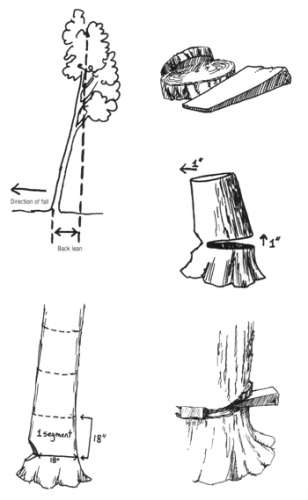It is usually easiest to fell a tree in the direction that it’s leaning, but sometimes it’s necessary to fell it in the opposite direction. A tree leaning away from the intended direction of fall has “back lean.” By using wedges and shims to lift the trunk off the stump, you can compensate for the back lean and bring the tree up and over in the intended direction.
Once you have established the direction of fall, you can calculate the amount of back lean that must be overcome and the amount of lift necessary to do so through some simple calculations. While standing away from the tree, at a position 90 degrees to the direction of fall, sight up to the top of the tree using a weighted string or an axe as a plumb and note the location on the ground. The back lean is the distance from this point along the intended direction of fall to the apex of the planned undercut. The apex will be the front of the hinge and the pivot point for the falling stem. The weight of the tree must be brought over this pivot point before the tree will fall. In the 60-foot-tall tree at right, the back lean is three feet.
Next, figure the diameter of the stump by measuring from the front of the hinge to the back edge of the tree (see illustration). The stump diameter is used to determine the number of segments in the tree; one segment is a section of the tree with a height equal to the stump diameter. Thus, the 60-foot-tall tree with an 18-inch stump diameter has 40 segments (720 inches divided by 18 inches equals 40).
If you raise the back edge of the lowest segment one inch, you will move its front edge one inch forward. At the same time, the top of our 40-segment tree will move forward 40 inches, enough to overcome its 3-foot back lean. If the same tree had a back lean of 4 feet, it would require 1 ¼ inches of lift (48 inches divided by 40 sections = 1.2 inches) to overcome the lean. When calculating the lift, be sure to add in the 3/8-inch saw kerf, which means that one inch of lift will require 1 3/8 inches of wedge.
A combination of wedges and shims can be used to give you more lift. Cut discs of ½-inch to an inch in thickness from hardwood branches for the shims. Do not taper the discs, as that will make them weak and liable to break in the notch. Using two wedges, side by side, drive one home so that there is a gap between the stem and the top of the other wedge. Place a shim in the gap above the free wedge until it is snug, and then pound in the shim by driving the wedge. This should either fell the tree or free up the other wedge for a thicker shim. Repeat this process with increasingly larger shims until the tree comes up over the pivot point, and then gravity will take care of the rest.



Discussion *